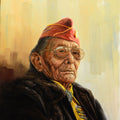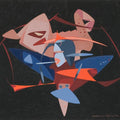Historic and Contemporary Western Native American Artists Added to Permanent Collection at SFMOMA
By Chadd Scott on
The San Francisco Museum of Modern Art has announced its acquisitions for the first half of 2025. Among the pieces entering SFMOMA’s permanent collection are a large number from western Native American artists.
The additions continue encouraging trends of major American institutions uplifting Native artists, both mid-career contemporary Native artists working at the edge of the avant-garde as well as the elder and ancestor artists whose shoulders they stand on.
Museums set the culture. Not the popular culture of any given moment in time. They aren’t – or shouldn’t be – swayed by the whims and tastes of the art market. Museums are bedrock. Once an artwork or artist goes into a museum collection, particularly one as esteemed as SFMOMA – comfortably among the 12 or 15 most prestigious art museums in America – that artist and artwork, by definition, become “great.” They go into the canon – the generally agreed upon ranking of “best of the best” from their era. They go into the textbooks. The art history classes. They’re studied by future artists. They become immortal.
That is the power of museums.
Most of the Native artists added to SFMOMA’s collection are familiar names to devotees of the genre. The San Francisco Museum of Modern Art, however, plays to a global audience. Its collection features iconic artworks from Henri Matisse and Diego Rivera, those sort of figures. Bringing more Native artists into the collection, establishing them as peers, is a huge deal for the artists and the Native art genre, further proof of its mainstreaming. Native art and artists are no longer niche; acquisitions like these by institutions like this prove that unequivocally.
Congratulations to Jean LaMarr (Northern Paiute/Pit River, b. 1945), Frank LaPena (Nomtipom Wintu, 1937–2019), Linda Lomahaftewa (Hopi/Choctaw, b. 1947), Melissa Cody (Diné, b. 1983), Harry Fonseca (Nisenan Maidu/Native Hawaiian/Portuguese, 1946–2006), and Mooshka (Kevin Cata) (Tewa/Ohkay Owingeh, 1965–2018).
All aside from Cody have connections to the Bay Area and, or Northern California.
LaMarr left home for San Jose City College in 1964 and then U.C. Berkeley, befriending artists and professors engaged with Chicanx political causes. She learned about the Mexican mural movement. She saw Chicanx artists reinforce their presence in society through painting murals as widely as possible.

Jean LaMarr, ‘Green Shawl, early 1970s; San Francisco Museum of Modern Art, Deaccessions Fund purchase; copyright Jean LaMarr; photo Don Ross.
At the same time, she dove into Indigenous activism. She participated in protests during the American Indian Occupation of Alcatraz in San Francisco in 1970. She participated in protests during the Pit River Occupation in Shasta County that same year when Native Americans disputed land claims made by Pacific Gas & Electric and the federal government.
In 1994, she relocated from San Francisco to the Susanville Indian Rancheria permanently to reconnect with her homeland and give back to her community. She established the Native American Graphics Workshop and studio space for Native artists to learn and experiment with printmaking, papermaking, painting, video and new forms of experimental art.
Museum exhibitions continue sharing her work widely.
Lomahaftewa resides in the “legend” category of Native American artists as part of the first class of students at the Institute of American Indian Arts in Santa Fe in 1962. Her classmates included T.C. Cannon, Earl Biss, and Doug Hyde. She later earned her BFA and MFA from the San Francisco Art Institute. Cannon, Biss and Hyde also spent time there. She went on to teach at the University of California, Berkeley,
Fonseca is one of the most prominent Native artists ever. His cartoony coyotes are a signature of American art.
Fonseca studied under LaPena at California State University in Sacramento. LaPena was a hugely influential California artist, teacher, dancer, singer, and leader acknowledged for his contributions to the visibility of Native arts. He served as the director of Native American Studies at CSU–Sacramento for over three decades and was a cofounder of the Maidu Dancers and Traditionalists, a group dedicated to preserving and sharing traditional dances and practices.
LaPena’s paintings highlight ancestral knowledge, legends, and symbols, as well as sacred sites. One of his most iconic works, the triptych North Mountain (1989), acquired by SFMOMA, depicts a snow-capped Mount Shasta under the outstretched wings of a bird and a starry sky. His mother’s family lived for generations in the Mount Shasta area, a site of personal and spiritual significance for the artist.

Frank LaPena, North Mountain, ca. 1989; San Francisco Museum of Modern Art, Deaccessions Fund purchase; copyright Frank LaPena; photo Don Ross.
Cody represents a younger generation, having turned 40 in 2023. Her revolutionary weavings reflect a contemporary, experimental spirit. Make no mistake, however, she’s as legit as it gets, the fourth generation of a prominent weaving family who began practicing as a 5-year-old. She’s also an IAIA graduate.
Cody’s tapestries carry forward the methods of traditional Navajo Germantown weaving, which developed out of the wool and blankets that were made in Germantown, PA and supplied by the US government to the Diné people during the forced expulsion from their territories in the mid-1800s. While acknowledging this history and working on a traditional Navajo loom, Cody exercises experimental palettes and patterns that animate through reinvention, reframing traditions as cycles of evolution.
A striking signature of Cody’s weavings are large areas of blank space. They are further distinguished by interrupted patterns, asymmetrical, almost jarring designs recalling old televisions on the fritz, and woven 3-D elements. Dopamine Regression (2010), one of Cody’s most significant early weavings, reflects on her father’s battle with Parkinson’s disease. At the top, a large red cross—associated with both the medical field and the figure of Spider Woman who taught the art of weaving in Navajo/Diné cosmovision—beams rainbow rays over stacked, patterned fields. Traditional serrated diamond forms contrast with zigzags resembling brain wave scans. Dopamine Regression is the first work by Cody to enter SFMOMA’s collection.
Of the group, Mooshka is the least well-known. He was unfamiliar to me, and little information exists about his career online. He moved to San Francisco from Los Angeles in 1985, working there across a variety of mediums into the new millennium.
Good on SFMOMA for this as well. Greatness shouldn’t be determined by notoriety. If museums are to be credited as the ultimate arbiters of taste, as gatekeepers of the culture, they have a responsibility to look deeper and wider than the names everyone knows.

Melissa Cody, ‘Dopamine Regression,’ 2010; San Francisco Museum of Modern Art, purchase, by exchange, through a gift of Michael D. Abrams; copyright Melissa Cody; photo Don Ross.
Postscript
Art lovers flying into or out of San Francisco’s international airport (SFO) be on the lookout for an exhibition by acclaimed Tlingit glass artist Preston Singletary (b. 1963). “Preston Singletary: Raven Visits SFO” shares the artist’s cutting-edge contemporary glassblowing, particularly his Raven sculptures.
Raven is an essential figure in Tlingit history. The Raven story, how he brought the world from darkness into light, has been passed down in many different forms through the millennia.
The exhibition can be seen at SFO’s International Terminal, Departures Level 3, Gallery 4A, pre-security through October 18, 2026. That means it’s free for the public to enjoy, with or without a plane ticket.
Singletary following Lomahaftewa, Fonseca, LaMarr and others into the permanent collection at SFMOMA one day would be a good bet.



